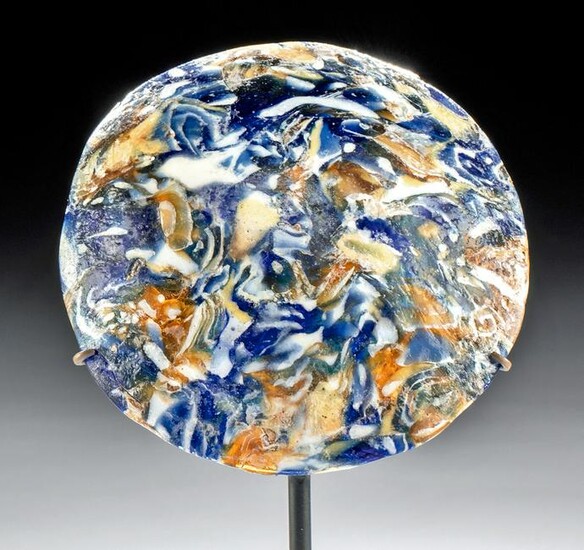Rare Roman Mosaic Glass Shallow Bowl
Roman, early Imperial Period, ca. 1st century BCE to early 1st century CE. A breathtaking glass bowl of a shallow, hemispherical form composed in the mosaic (or millefiori) technique with canes of translucent cobalt-blue and yellow-orange glass with integral opaque white 'eye' accent streaks throughout. The irregular form of the rim creates a gentle ovoid profile with a slightly rounded but stable base. The stunning coloration is of the highest quality produced in the early Imperial Period and can be illuminated next to a bright light source. This is an exceedingly rare and important example of a simple bowl because it exhibits an uncarinated, footless style typically seen in mosaic glass patella cups. The uncomplicated nature of this bowl perhaps suggests its utilitarian purpose as a salt dish, a trinket receptacle, or even an offering vessel, and its undeniable beauty is made evident by its expert construction and incredible coloration. Size: 3.25" W x 3.3" H (8.3 cm x 8.4 cm); 4.7" H (11.9 cm) on included custom stand.
Pliny described the eye-like forms of mosaic glass in his Natural History, "Pieces of broken glass can, when heated to a moderate temperature, be stuck together, but that is all. They can never again be completely melted except into globules separate from each other, as happens in the making of the bits of glass sometimes called 'eyes,' and which in some cases have a variety of colors arranged in several different patterns." (Pliny, Natural History XXXVI.199)
For a ribbed bowl created in a stylistically similar fashion with blue and purple glass with white accents, please see The Metropolitan Museum of Art, accession number 17.194.265
For an example of an uncarinated mosaic glass bowl from the Eastern Roman Empire, please see The Metropolitan Museum of Art, accession number 17.194.1481
A strikingly similar example, of a larger form and with only white and blue glass, hammered for GBP 18,750 ($24,464.06) at Bonhams, London, New Bond Street "Antiquities" auction (April 3, 2014, lot 125).
Provenance: private East Coast, USA collection; ex-Martin Wunsch collection, New York, USA, acquired in the 1980s; ex-Christopher Sheppard collection, London, UK, acquired in the 1980s; ex-Dr. Klaus Morkramer collection, Germany, acquired in the 1970s
All items legal to buy/sell under U.S. Statute covering cultural patrimony Code 2600, CHAPTER 14, and are guaranteed to be as described or your money back.
A Certificate of Authenticity will accompany all winning bids.
We ship worldwide to most countries and handle all shipping in-house for your convenience.
#152853
Condition Report: Repaired from multiple large pieces, with light adhesive residue along some break lines, and clear stabilization material across most surfaces. Minor nicks and pitting to base, rim, and basin, with light encrustations within some recessed areas, and minor weathering. Gorgeous coloration throughout.
View it on
Estimate
Time, Location
Auction House
Roman, early Imperial Period, ca. 1st century BCE to early 1st century CE. A breathtaking glass bowl of a shallow, hemispherical form composed in the mosaic (or millefiori) technique with canes of translucent cobalt-blue and yellow-orange glass with integral opaque white 'eye' accent streaks throughout. The irregular form of the rim creates a gentle ovoid profile with a slightly rounded but stable base. The stunning coloration is of the highest quality produced in the early Imperial Period and can be illuminated next to a bright light source. This is an exceedingly rare and important example of a simple bowl because it exhibits an uncarinated, footless style typically seen in mosaic glass patella cups. The uncomplicated nature of this bowl perhaps suggests its utilitarian purpose as a salt dish, a trinket receptacle, or even an offering vessel, and its undeniable beauty is made evident by its expert construction and incredible coloration. Size: 3.25" W x 3.3" H (8.3 cm x 8.4 cm); 4.7" H (11.9 cm) on included custom stand.
Pliny described the eye-like forms of mosaic glass in his Natural History, "Pieces of broken glass can, when heated to a moderate temperature, be stuck together, but that is all. They can never again be completely melted except into globules separate from each other, as happens in the making of the bits of glass sometimes called 'eyes,' and which in some cases have a variety of colors arranged in several different patterns." (Pliny, Natural History XXXVI.199)
For a ribbed bowl created in a stylistically similar fashion with blue and purple glass with white accents, please see The Metropolitan Museum of Art, accession number 17.194.265
For an example of an uncarinated mosaic glass bowl from the Eastern Roman Empire, please see The Metropolitan Museum of Art, accession number 17.194.1481
A strikingly similar example, of a larger form and with only white and blue glass, hammered for GBP 18,750 ($24,464.06) at Bonhams, London, New Bond Street "Antiquities" auction (April 3, 2014, lot 125).
Provenance: private East Coast, USA collection; ex-Martin Wunsch collection, New York, USA, acquired in the 1980s; ex-Christopher Sheppard collection, London, UK, acquired in the 1980s; ex-Dr. Klaus Morkramer collection, Germany, acquired in the 1970s
All items legal to buy/sell under U.S. Statute covering cultural patrimony Code 2600, CHAPTER 14, and are guaranteed to be as described or your money back.
A Certificate of Authenticity will accompany all winning bids.
We ship worldwide to most countries and handle all shipping in-house for your convenience.
#152853
Condition Report: Repaired from multiple large pieces, with light adhesive residue along some break lines, and clear stabilization material across most surfaces. Minor nicks and pitting to base, rim, and basin, with light encrustations within some recessed areas, and minor weathering. Gorgeous coloration throughout.



